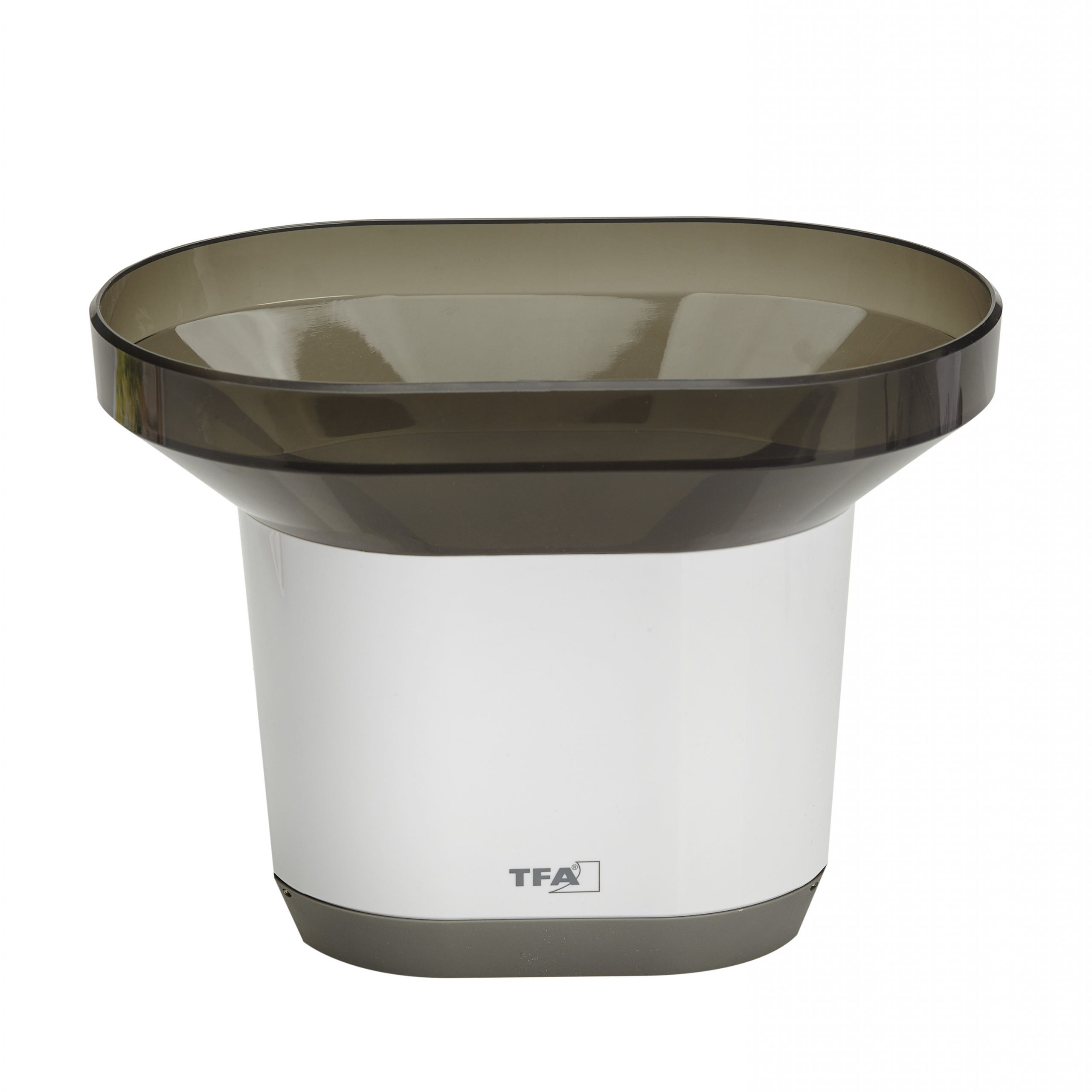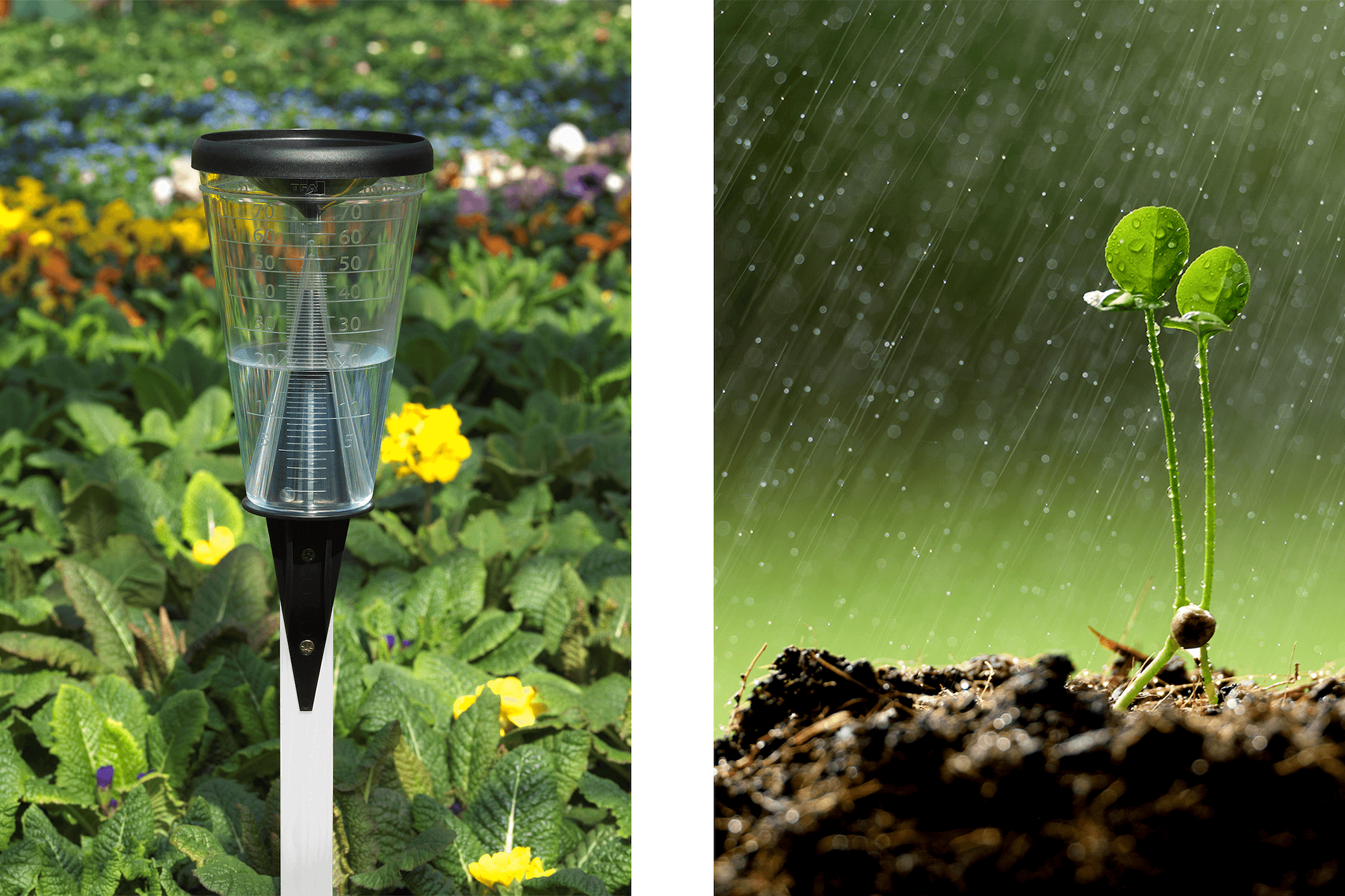
Item number: 30.3802
The amount and frequency of precipitation are not only decisive factors for the local climate in different areas, but also for their vegetation, agriculture and culture. Storms with heavy rain, hail or snow, but also the lack of precipitation, can lead to disasters, such as floods, droughts or destroyed habitats.
Measuring precipitation is important for estimating how much precipitation has fallen in a location, such as your garden, and over what period of time. Analysing precipitation data makes it possible to identify long-term trends and patterns and make informed decisions about water management and climate change. We explain what is meant by precipitation and how it is measured.
The amount of precipitation is measured with the help of rain gauges or precipitation sensors. In most cases, the rain is collected in a container from which the amount of water can be read. Common measuring instruments for this purpose are rain gauges.
Some weather stations also offer rain gauge systems. For (hobby) meteorologists who like to make extensive weather observations and weather recordings, a weather station with an anemometer included as well as a rain sensor is helpful. Air pressure is an important factor in understanding precipitation. By measuring air pressure with a barometer, meteorologists can make forecasts about precipitation events, as changes in air pressure can indicate changes in atmospheric circulation and thus possible precipitation.
In addition to calculating directly using on-site measuring devices, such as a precipitation sensor, precipitation intensities can also be determined by rainfall radars. A rain radar, a sophisticated radar system, emits electromagnetic pulses that are reflected by water droplets or snow crystals. Based on the return time and intensity of these signals, the precipitation radar can determine the position, intensity and movement of the precipitation. This enables more accurate weather forecasting, monitoring of heavy rain events and hydrological analyses for flood forecasting.
The amount of precipitation is usually given in litres per square metre (l/sq. m.) or the height in millimetres (mm). The scale of a rain gauge is given in millimetres. Here, one millimetre of precipitation height in the cup equals one litre of rain per square metre. This measurement together with the indication of the time period (the usual measurement interval is 24 hours (1 day), but also 48 or 72h for longer lasting heavy rain events) in which the measurement took place then gives information about the amount of precipitation.

Aggregating the daily values produces a summarised representation of precipitation for the entire month. Monthly totals are of great importance for identifying seasonal precipitation patterns, detecting droughts and analysing long-term trends in precipitation. They serve as a valuable basis for scientific studies, agricultural planning, water resource management and other areas where a sound understanding of precipitation is critical.
Precipitation duration is an important aspect that indicates the period during which precipitation occurs. It refers to the period of time during which rain, snow or hail falls continuously or intermittently.The duration of precipitation can range from a few minutes to several days or even weeks. It affects the total amount of precipitation, soil moisture, hydrologic conditions and risk of flooding.
The exact duration of precipitation is determined by meteorological observations and measurements. This parameter is important for various applications, such as agricultural irrigation, water supply, infrastructure project planning and flood risk assessment. Accurate knowledge of precipitation duration enables better prediction and management of the impact of the precipitation event.
For weather enthusiasts, farmers, hobby gardeners and meteorologists, the local weather, and especially the precipitation, plays a major role. Keeping an eye on the amount of precipitation with a precipitation sensor is essential to know if the rain is enough for your plants or lawn to grow or if you need to water additionally. Since rainfall distribution varies greatly by region, the local weather report is usually too inaccurate when it comes to your own garden. Using a rain gauge sounds like child’s play to most, but there are a few things to keep in mind to get optimal readings from rain gauges.
In meteorology, precipitation means water that falls from the air onto the earth’s surface due to gravity. In addition to liquid precipitation, such as rain, precipitation also includes solid aggregate states, such as snow, hail or sleet.
A distinction is made between falling precipitation (e.g. rain, snow), swirling precipitation (e.g. driving snow) and deposited precipitation (e.g. snow cover).
Precipitation is formed when water evaporates from oceans, lakes or land and, there, the water vapour cools and condenses into small droplets, forming clouds. These clouds can continue to grow by absorbing more water vapour. Once the droplets in the clouds reach a certain size and weight, they become too heavy to float in the air – the cloud droplets fall back to the earth’s surface as precipitation. This process of evaporation, condensation and precipitation is called the water cycle and is an important part of the global climate system. The water cycle plays a crucial role in the distribution of water resources on earth and influences weather patterns in different regions.
12 mm of precipitation means that 12 litres of water per square metre fell in a given area within a period of time. As mentioned earlier, this is a unit of measurement to quantify the amount of precipitation.
This is a moderate amount of precipitation, which in most cases is considered sufficient to moisten the soil and support plant growth. However, the exact impact of 12 mm of precipitation depends on several factors, such as the condition of the soil, evaporation and climatic conditions. In dry regions, 12 mm of precipitation may be considered precious, while in wetter areas it may be considered normal or insignificant.
Water changes its appearance according to the temperature. Water generally reaches its freezing point at 0 degrees Celsius and thereby becomes solid. This also changes the precipitation that falls from clouds; rain becomes snow, sleet or hail.
There are different forms of precipitation. Liquid precipitation includes rain, freezing rain and droplets. Solid precipitation includes hail, snow, sleet, snow grains and ice pellets.
Rain refers to liquid water that falls from the air to the earth due to gravity. It is the most common form of precipitation from clouds. Other types of precipitation include water in a frozen aggregate state, such as snow or hail.

A distinction is made between different forms of rain depending on their origin, duration, intensity, effect and geographical occurrence. Some examples are orographic rainfall, heavy rain, continuous rain or tropical rain.
A raindrop, which is between 0.5 and 1.5mm in size, falls at a speed of about 20km/h. To determine the amount of rain and also the intensity and duration of the rain, you need a rain gauge that works analogically or digitally.
Average precipitation varies greatly depending on the region, in Germany and also worldwide. While in tropical regions at the equator, a so-called low-pressure trough with weeks of rain is normal, there is hardly any vegetation in desert regions due to their aridity. In Germany, the south is hotter, but it also has more rainy days than the north.
But how much does it rain in Germany?
The average precipitation per year in Germany is 500-1000l per square metre, but this has decreased in recent years. While it rained 700l in 2014, there was only 590l per square metre in 2018.
Now it’s your turn: Which countries probably have the most or least precipitation in the world?
Which are the 3 countries with the most precipitation in the world?
Among the countries with the highest rainfall are Colombia, Sao Tome and Principe and Papua New Guinea, with over 3000l of rain per square metre in a year. These countries are located near the equator with intensive low-pressure areas.
Which are the 3 countries with the least precipitation in the world?
The rain gauges in Egypt, Libya and Saudi Arabia remain largely empty with less than 75l of precipitation per year. These subtropical desert regions are so dry because the cumulus clouds that form over the equator have already emptied themselves in the humid tropical regions near the equator. The cooled, dry air then sinks back to the ground. During the day, temperatures rise sharply due to the strong sunshine and lack of cloud cover.
A large amount of precipitation in an often rather short period of time is referred to as heavy rain. A severe weather warning due to heavy rain is issued from a rainfall amount of 25 litres per square metre within one hour. Since the ground is usually unable to absorb these extreme amounts of water, such storms can lead to flooding, flash floods or landslides.
The record rainfall from China is an incredible 401 litres per square metre.
Hail is a form of solid precipitation in which balls or clumps of ice fall to earth from the air due to gravity. If the diameter of the spheres is 0.5cm or more, they are called hailstones; anything smaller is called sleet.
Hail is formed in thunderclouds, where supercooled water droplets combine with ‘crystallisation grains’ to form clumps. If there are few of these grains and thus a large excess of water, more and more water is deposited on a hailstone due to bobbing movements caused by wind.
This allows the hailstones to grow to an impressive size before they become too heavy and fall out of the cloud to the ground.
Hailstorms usually occur during a relatively warm season, in Germany increasingly in April. Since the thunderclouds extend to a precipitation height of more than 10km, the low sub-zero temperatures necessary for the formation of ice prevail here.
Depending on their size and speed hailstones can cause major damage to cars and glass panes as well as injuries to people or animals.
Hailstones can reach speeds of well over 150km/h. The largest hailstone was found in the United States and had a diameter of 20cm
When it comes to hail, what is often measured is the size of the individual hailstones. To measure the amount of precipitation, the water equivalent of the melted hailstones can be measured in a rain gauge or precipitation sensor.
Snow refers to fine ice crystals that fall from the air to the earth due to gravity. It is the most common form of solid precipitation. Other forms of solid precipitation include hail or sleet.
Snow is usually formed in high, cold layers of air by small water droplets freezing in clouds at temperatures in the air below minus 4 degrees. Ice crystals can also form directly from water vapour when it attaches to what is known as a freezing nucleus. The resulting ice crystals clump together over time to form larger flakes, which fall to earth in the form of snow when they reach a certain weight.
Depending on temperature and humidity, their shape and size vary greatly. Snowflakes become largest at temperatures just below freezing and high humidity. At temperatures below -30 degrees in high air spaces, snow hardly ever falls because the air is often too dry.
Due to the special formation of snow, it occurs exactly like this only in nature. Snow from a snow gun, for example, has a much higher density. Snowflakes have a delicate structure and occur in many variations. Snow has a fall rate of about 4km/h and is therefore much slower than rain or hail.
The depth of snow and new snow are usually measured in centimetres. One can also measure snow in its melted state using a precipitation gauge. Due to the low density of snow, however, even a small amount of water can result in a comparatively high amount of snow.